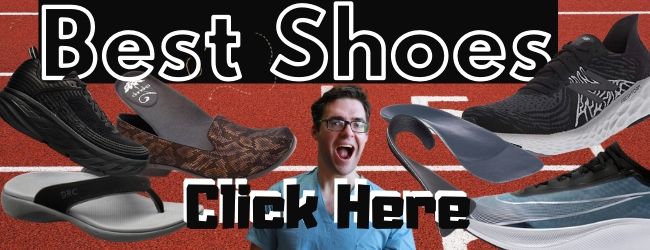- We focus on what has worked for 10,000+ patients & medical research.
- The #1 goal is to keep costs LOW and treatment SIMPLE.
- Just remember this is for educational reference only.
- If you have a medical problem visit with your personal doctor.
- Please comment if any questions!
Outside of the Foot Pain [Lateral Foot Pain]
Pain On The Outside Of Your Foot? [Causes & Best Treatment]
Do You Have Pain On Outside Of Your Foot? 95% of the time, it is due to your foot turning out. We share the Best Treatment SECRET to FIX this at HOME!
Look:
- We will show you an animated diagnosis & treatment guide, photos, and the best FAST treatment options outside the foot pain.
- These are simple & EASY options that we have seen success with.
- Also included is our outside of the foot pain video guide!
So, Let’s Get STARTED!
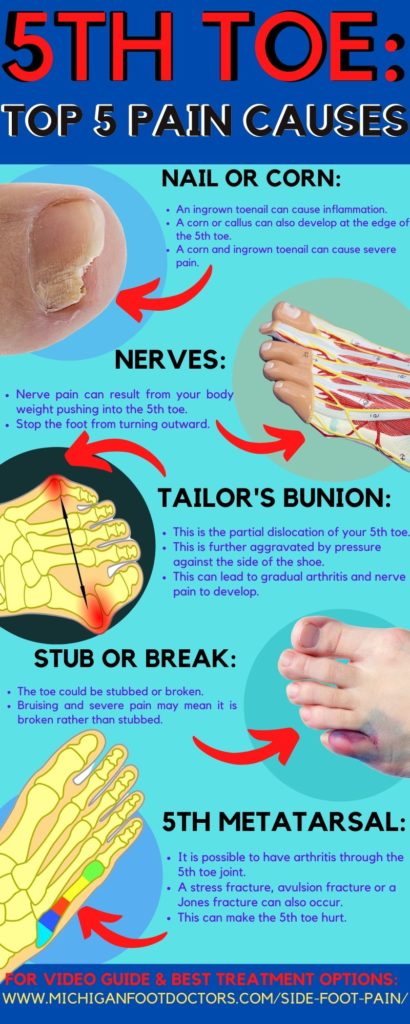
Table of Contents
Outside of the Foot Pain Picture Gallery:
Look:
- Fifth toe pain usually has nothing wrong with the bone unless it has recently been broken. The pain usually results from pressure against the front of the shoe, causing a callus or ingrown toenail.
- The fifth toe joint can cause a Tailor’s bunion to occur. This can also result in nerve pain and arthritis of the fifth toe joint.
- The bone connecting to the fifth toe is called the fifth metatarsal. It is possible to develop a stress fracture or “Jones” fracture.
- It is also possible to have pain and tendons and nerves outside the ankle from pressure against the outside of the shoe.
- The peroneal tendons can also be causing pain. This means the peroneus brevis tendon and the peroneus longus tendon.
- Cuboid syndrome can also cause pain at the back and outside of the foot.
Click on the photo gallery to see descriptions!
Causes Of Pain On Outside Of Foot:
The outside of your foot is a hard rigid beam of bone compared to the inside of the foot.
- This is more likely to cause tissue irritation.
- Irritation leads to nerve compression.
- Bone compression will be more of a sore and aching pain.
- Nerve compression can act as numbness, burning, or tingling.
- It is also possible to have tendon pain, stress fractures, or broken bones!
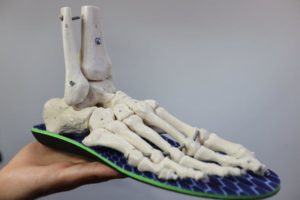
Symptoms of Outside Of The Foot Pain:
The symptoms are usually compression. This can lead to:
- Numbness.
- Burning.
- Tingling.
- Sore red skin.
- It can get so sore that any touching to the site can cause pain.
Summary of Causes & Home Treatment Guides:
Read further to learn about these:
1)Outside of the 5th toe pain:
- Pinky toe pain due to compression.
- Specific 5th toe injuries.
- Tailor’s bunion or bunionette.
2)Outside of the middle of the foot pain (outside the arch):
- Peroneus brevis tendonitis.
- 5th metatarsal due to compression.
- 5th metatarsal injuries.
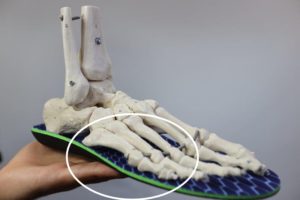
3)Outside of the ankle pain:
- Peroneal tendon pain.
- Subtalar Joint Pain.
- Ankle Tendon Pain.
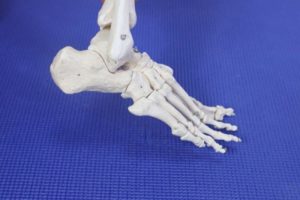
Foot Pain Outside Edge Of Pinky (5th) Toe:
Pinky toe pain is widespread:
- The most common reason the pinky toe becomes painful is that it is becoming compressed in the front of your shoe.
- You can see that if you step on the ground while barefoot, your font of foot can externally rotate towards the outside of your body.
What Can Lead To Pinky Toe Compression & Pain?
- You can imagine that with a less supportive pair of shoes such as a pair of flats, a pair of sandals, or poor running shoe or dress shoe, the foot will simply crush into the edge of the shoe.
- When people come into our clinic and reevaluate them standing in their shoe, the fifth toe is almost always getting jammed against the edge of the shoe, and all the other toes are crowding into it.
What else can outward foot rotation cause?
- This leads to your fifth toe rotating underneath the fourth toe, leading to symptoms such as numbness, burning, and tingling, especially at night.
- The symptoms develop because the toe is getting bruised up during the day, not because it is broken and not because you have some type of nerve disorder or deformity.
Quick Outside of the Foot Treatment Overview:
- The #1 priority is to stop your foot from twisting outward in your shoe.
- The best way to prevent your foot from twisting out is a very good supportive shoe combined with an orthotic.
- This works for 95% of our patients.
- This can seem counter-intuitive because the best way to do this is an orthotic.
- The second thing you should do is find a gel pad to take care of this problem.
Specific 5th Toe Injuries:
- The outward rotation of the foot is the most common cause.
- But these are more specific injuries that this could lead to:
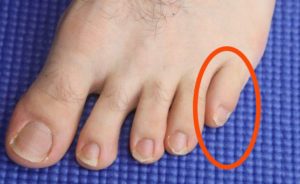
A)5th Toe Numbness, burning, or tingling:
- This is most common after standing, walking, or running.
- Numbness burning and tingling in the pinky toe does not mean that you have a lacerated nerve or some type of nerve disease. The most common cause of this by far is too much bruising, swelling, and pain during the day.
- The reason you get numbness, burning, and tingling is because your nerve, just like your skin can get bruised and simply stop working properly. This is your nerves trying to tell your body that you’re taking way too much damage in something worse will happen.
Why is pain relief a mistake?
- A common mistake that people make is trying to numb this nerve pain, but all this will get you is further damage to the fifth toe site and a need for more pain medication.
The key is to find a permanent solution to prevent pain:
- A better solution would be to prevent the fifth toe from jamming against the shoe in the first place, by wearing good supportive orthotics, and good supportive shoes.
- Look above for our orthotic recommendations.
- This is usually associated due to compression of the 5th metatarsal against the shoe.
- You can also consider wearing a larger shoe in the front.
B) 5th Toe Callus, Bump Or Corn:
What can cause a callus, bump or corn to develop?
- Calluses and core are also very common to have develop on the knuckle of the fifth toe joint.
- Initially this callous or corn develop due to rubbing against the shoe, but now this is almost like a pebble that is stuck to your skin causing its own source of pain.
What can be done about this corn and callus?
- If this is something that is causing tremendous pain, in our offices we could trim this down and correct your biomechanics and get you into some proper shoe gear.
- Calluses and corns can feel like a pebble between your toes, this can lead to a blister and significant pain!
- These should be treated.
How can you correct this permanently?
- But the most important key is preventing the outward rotation of your foot, this stops it from developing in the first place!
- The most common cause of developing a corn callous or bump on your fifth toe is due to many years or months of rubbing against the edge of your shoe. These bumps and skin disorders are simply a symptom of a larger biomechanical problem.
- There is nothing wrong with your fifth toe, it is just taking a lot of abuse during the day.
C)Pinky Toe Sprain:
What is a pinky toe sprain?
- It is also very possible to sprain or injure your pinky toe.
- If you feel that you really did injure or bump your fifth toe, it is possible that you have a pinky toe sprain.
- There are three grades of pinky toe sprain, these range from bruising, to partial tearing to full tearing. It is possible to even dislocate your toe or break it. If you do have a black or bruised pinky toe, it is possible that you even have a broken pinky toe.
How do you treat a pinky toe sprain?
- The real key to treating a sprain pinky toe, is to prevent it from rubbing against the edge of your shoe. If you feel that it may be dislocated or more permanently damaged, at our clinics we can take an x-ray or an MRI to make sure that nothing further is going on.
- A sprained or broken pinky toe can take many months to get completely better. We def see our patients who must work on their feet all day long struggle with this for numerous weeks or months. There definitely is no perfect solution, but to prevent damage from being done daily. Eventually you will healing you will feel significantly better.
- It you jammed it very hard, consider a sprain!
- The real key is gel pads and orthotics to stop outward twisting pressure.
D)Bunionette:
What is a tailor’s bunion or bunionette?
- At the front of the foot you can develop a bunion at the outside of the foot by the base of the toes.
- It is possible to develop a bunion tear fifth toe. This is something called the bunionette, it is an early dislocation of your fifth metatarsal phalangeal joint.
- This is almost exactly like a bunion for your big toe joint. It happens due to flattening of your foot. It is very common to also develop a callus over this fifth toe joint. This callous or corn may also need to be trimmed down.
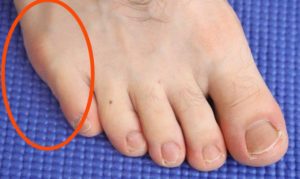
How do you treat a bunionette or tailor’s bunion at home?
- The pain can be relieved with 5th toe bunion padding & shoe accommodation. But in the end only surgery will permanently correct the deformity.
- We can usually avoid surgery on this fifth toe joint, we have tremendous success for our patients by making smart orthotic decisions, good gel padding and braces, and good shoe gear choices.
- The pain to this protruding bone can always be made to feel better by correcting your biomechanics. Over 90% of the time we can avoid doing any type of surgery. We may have to x-ray or image this joint before making a good decision.
These are the recommended gel pads for all types of your fifth toe pain:
- Read the reviews of each individual gel pad to see which are best for you problem!










Outside of the Middle of the Foot Pain:
- This is also known as foot pain Outside the Arch.
Foot Pain Outside The Arch is usually two to one of 3 very common problems.
A) 5th metatarsal styloid process:
- The 5th metatarsal styloid process is a normal bone on the middle outside of your foot.
- Get a good gel pad to offload the side of your foot and you will feel much better.
- This is a normal bone that is supposed to be there!
- So don’t worry, this is not a tumor!
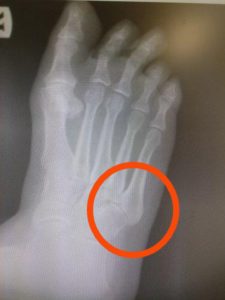
B) Peroneus Brevis Tendonitis:
- This is the most common source of injury.
- The peroneus brevis tendon, down to the protruding bone on the outside of your foot. This muscle and tendon are responsible for turning your foot outward.This tendon is very commonly irritated and can cause you extensive pain especially when standing all day. It is a muscle responsible for letting you adjust to uneven ground and standing for long periods of time. If this seems like it maybe you, you may have peroneus brevis tendinitis.
- This is a very long tendon that starts along the entire outside of your leg, comes down around the outside of your fibula, and inserts into the base of your fifth metatarsal styloid process.
- The best way to image this is to do an ultrasound which we can do an office, or an MRI which would have to be done in the hospital.
- It can become irritated very easily.
- If you plan on heavy duty activity, work or even running, look at the brace below.
- Use the below braces for light duty activity like walking around the house or in tight shoes.
Best and most supportive braces for peroneus brevis tendonitis:
- This brace is much more supportive for heavy duty activity.
- This might have a hard time fitting in tight shoes, so be aware!
C) Jones Fracture:
What is a Jones Fracture?
- A Jones fracture is a break in the base of the fifth metatarsal of the foot.
- You can feel it on the side of your foot right around the middle.
- This usually shows black and blue bruising when it happens.
Why does a Jones fracture take a long time to recover?
- This is a notoriously difficult part of the foot to heal because the Peroneus Brevis Muscle is always pulling it apart.
- Don’t worry, a Jones fracture usually does not happen unless you fall with a significant force in inversion sprain.
- Even if you do have a Jones fracture, no worry most of the time it does not require surgery. If you have any type of health conditions which may prolong healing or any type of further risk factors, we may opt to avoid surgery altogether.
- If you are an athlete, and are looking for quicker and high durability healing time, surgery does make sense for your Jones fracture in that circumstance.
- It might also make sense if your bone is shifted.
How long does a Jones fracture take to heal if I get surgery?
- Jones fracture surgery is a very successful procedure, and the relative healing time includes 2 to 4 weeks and cast, then approximately four weeks in a walking boot.
- At that point you then transition into a good running shoe.
What are some possible treatment options for a 5th metatarsal injury?
- If you do have a fracture, make sure to see your doctor!
- But consider the products below for treatment.
Pain Outside the Ankle and Below the Ankle:
Pain On Outside Of Foot Below The Ankle:
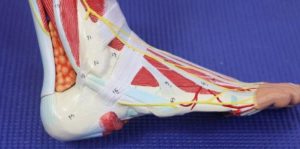
A)Sinus Tarsi pain:
Most cause of pain in almost everyone!:
- Outside of the Ankle & Below the Ankle pain is very common.
- Pain on the outside of the foot below the ankle, is usually in a region called the sinus tarsi joint. This feels like a valley if you press down with your thumb into the depressed area.
- As you put weight on this joint while standing, this joint will compress.
- This is a space that occurs between your calcaneus and your talus bone. This is a completely normal joint space, nothing is deformed, but it can get inflamed and painful with too much pressure.
- Almost everyone has a degree of pain to this area!
Why do I have sinus tarsi pain?
- The reason you have sinus tarsi pain, is likely due to being too flat footed, or having inappropriate shoes and having to stand for long period of time.
- We also see this in runners and people who walk long distances during the day.
- Don’t worry this is a very common problem we see in our clinic, and we can definitely get you feeling better very quickly.
- This pain is mostly commonly due tight Achilles tendon and hamstring tightness secondary to previously sprained ankles, instability, bone pain, tendonitis or pain after running.
How can I treat sinus tarsi joint pain at home?:
- When we see patients that have pain in this area, it is almost always the sinus tarsi joint. The sinus tarsi joint respond very well to injection, orthotics modification, and could shoe gear choices.
- For you at home orthotics can give about 50-75% pain relief.
- If that didn’t do it, get a lace up or supportive ankle brace listed on this page.
- If that still didn’t work, make sure to correct the tightness through your Achilles tendon & Hamstring.
B)5th Metatarsal Styloid Process Pain:

The styloid process is the base of the 5th metatarsal, do not worry, this is a normal bone, not a tumor!
What is 5th metatarsal styloid process pain?
- What is 5th metatarsal styloid process pain?
- This has been addressed above. So SCROLL UP!
- This is a normal bone that is simply turning out against your shoe.
How do I treat my 5th metatarsal styloid process pain?
- The single best way is to get a great pair of shoes.
- The second best is to get treated with orthotics. This will solve the majority of your pain.
- The third best way is to wear a compression ankle brace.
Outside of the Ankle Joint Pain:
A) Ankle Ligament Injury:
What is a sprained ankle?
- There are 3 ankle ligaments within this joint.
- They could very easily get sprained.
- This is usually a traumatic injury or fall.
- This is rarely a gradual chronic injury.
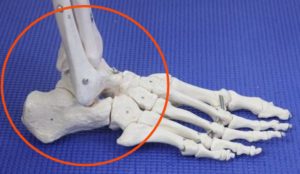
What if I never suffered a sprain or fall?
- Most likely this is sinus tarsi pain.
B) Sinus Tarsi Pain:
Once more sinus tarsi pain is probably the most common cause:
- If your pain is stretching up into the ankle joint, you may consider that you do have some ankle joint irritation.
- When people have pain in the back of their foot around the ankle, it is usually the sinus tarsi joint or the ankle joint.
Why is the sinus tarsi the most commonly sore and irritated area?
- The ankle joint itself is comprised of the tibia and fibula.
- If it is on the outside of your ankle joint, it is usually pain due to the fibula, pressing down against the sinus tarsi joint.
- It is also very common to see your fibula rubbing up against the side of your shoe.
- These problems are almost always biomechanical problems, this means that your foot is simply turning out too much and tilting out against her ankle joint.
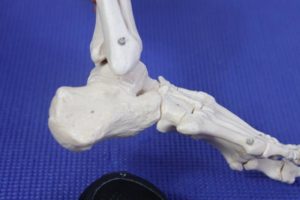
What type of imaging can confirm my outside of the ankle injury:
- With an MRI it is very rare to see any true tearing of the ligaments or destruction of the bone.
- If your pain is chronic it is most likely arthritis or overuse.
- This can usually be confirmed on X-ray.
- On the other hand, on MRIs it is much more common to see chronic deterioration of the cartilage, bone spur formations, and joint fluid buildup within these joints due to chronic overuse.
How can I treat my outside of the ankle pain at home?
- I know I keep repeating myself and seeing the same kinds of things, but it is amazing how much we can cure this pain by simply wearing the proper orthotics, and the proper shoe gear.
- Below is a list of common outside of the foot and ankle conditions.
Consider the following causes:
- Ankle Sprain Treatment.
- Rolled Ankle Recovery Time.
- High Ankle Sprain Recovery Time.
- Ankle Tendonitis.
- Sore Ankles After Running.
- Broken Ankle Recovery Time.
- Broken Ankle or Sprained Ankle?
- Peroneus Longus Tendonitis.
- Peroneus Brevis Tendonitis.
Sharp Pain On Outside Of Foot:
- Sharp pain on the outside of the foot is usually due to nerve compression.
- Sharp pain on the outside of the foot usually means that the nerve is irritated. Don’t worry this doesn’t mean that something’s wrong with your nerve, or that you have been type of nerve disorder.
- Almost all the time we see the symptoms, there is simply swelling and irritation to the joints on the outside of the foot, and the nerves overlying the start irritated and throbbing.
- There are two nerves that run along the outside of your foot.
- The nerve that runs behind your fibula, on the outside of your heel, and on the bottom outside of your foot is called your sural nerve.
- The nerve that runs in front of your fibula is called the superficial peroneal nerve.
- These two nerves can very easily be bruised and injured, this leads to symptoms like numbness burning and tingling. Most people feel symptoms like this at night when their foot is swollen after a full days walking.
- This occurs when your foot compresses against your shoe during walking or running.
- This pain is known as neuropraxia.
- The most common site is the base of the 5th metatarsal.
- This can cause the pinky toe to go numb.
Outside Foot Pain After Running:
- This is also most common felt as a sharp, numbness, burning or tingling feeling.
- This is nerve compression due to excess pain and friction.
- This is almost always at the 5th toe or pinky toe.
- Outside of the foot pain after running is very frequently cost irritation of the two nerves I mentioned above. Running is about the most damaging thing you can do to your foot if you do not have proper foot mechanics. Therefore it becomes even more important to wear the proper orthotics and shoes while running.
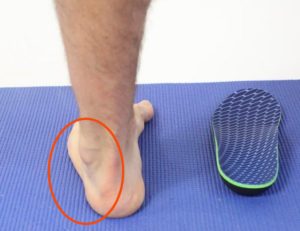
- If you do plan on running long distances, it is very important to see a podiatrist get your foot evaluated. Think about how much your body weighs, and how many thousands of times your foot will be slamming into hard concrete and floor. You can do some serious damage to your foot if it is not landing precisely the way it was intended to.
- The human body was not designed to run tens of miles every day, and if you are going to be doing it, you must make sure that you are optimized to do so. I always tell my patients that if you are having foot pain, there are better ways to exercise slamming your foot with hundreds of pounds of force into cement 10,000 times in a row. If your foot is hurting and he cannot see podiatrist try to stick to swimming, riding a bike or alternative exercises until your foot pain gets better.
- Don’t keep falling into the same trap and causing the same type of damage to your foot, you need precise orthotics and shoes to get your foot feeling better. You probably need to get your muscles legs and flexibility assessed by an expert to make sure that you do not have any unequal muscle strength, or flexibility.
Outside of the Foot Home Treatment:
- If you have 5th toe pain, tailor’s bunion pain, outside of the foot pain, or other lateral foot pain, this guide is for you!
- These are the recommended treatment products that will help you get better the fastest.
- The key is to stop your foot from turning outward and causing further damage to your foot.
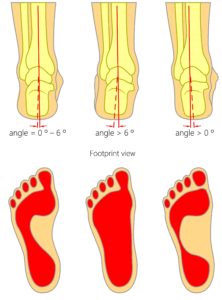
The real key to fix outside of the foot pain in order:
1) Most important is a good shoe & a good insole for your shoe.
- Good shoes and good foot insoles are the best value and best long-term option.
- This will stop your foot from turning outward.
- Give these 1-2 weeks of effort, and you will really notice the pain relief.
- This does not instantly fix the pain but prevents future damage.
2) Gel pad to offload the toe.
- This will give your toes some cushion to keep pressure off the toes.
- Read below to see the specific gel pads for each specific condition.
3) Ankle brace for a possible correction.
- Check the recommended braces below.
- For ankle pain, this is almost guaranteed to improve your problem.
4) Menthol-based cream for pain relief.
- Creams and gels like Biofreeze act like ice but save you 20 minutes!
- Check below for our recommended pain relief options.
Best Treatment Products:
5th Toe Gel Pads:
- Fifth toe gel pads can stop your fifth toe or your Taylor’s bunion from rubbing against the side of your shoe.
- There are downsides because these don’t last forever, and they do start to break apart and develop older.
- They can be a low-cost option for tighter shoes during business meetings and at work.










Topical Pain Relief Creams:
- Menthol-based creams have been studied medically and show safety and excellent results.
- This is best for nerve irritation.
- This can help with the nerve pain on the outside of the foot. Just don’t use this as your only treatment option.
- This is not fluff, and these are scientifically backed!
- Bio-freeze is cost-effective and shows great results.
- This is more for people who have difficulty sleeping or walking due to significant issues.








Massage & Ice Products:
- Ice is an excellent option that can be safe for almost everyone.
- There are many nerves, ligaments, and tendons on the outside of your foot.
- This can help calm the inflammation until you fix the biomechanics making your foot turn outward.
- There is some debate about whether icing is worth doing, but this can help limit the need for medications and keep your options open for chronic pain.
- This works great for your arch, less for the ball of the foot.
- The more muscle and ligament tissue there is, the better ice will work there.






Massage Sticks:
- These can work great for loosening your muscles.
- More flexibility will make your foot turn out less.
- This is a very counter-intuitive way to take pressure off of the outside of your foot!
- This allows less tightness and pressure on the ball of your foot.
- This is very effective for the arch, the gastrocnemius, calf muscle, and the hamstring and thigh muscles.
- This also works very well for the gluteus muscles if you are having butt cheek or hip pain.






Best Shoes for Side of Foot Pain:
- Getting a great supportive pair of shoes will make sure that there is pressure removed from the outside of your foot
- This is especially important if you have flat feet.
- Consider shoes combined with a good supportive orthotic for the best pain relief!.
- The following link will show you what our favorites are.
Best Orthotics for Side of Foot Pain:
- Orthotics are the single most important way to improve your outside of the foot pain, Seriously!
- Most people don’t think orthotics will fix their foot pain.
- Besides trauma, 95% of all 5th toe, middle of the foot, and outside of the ankle pain can be improved with orthotics.
- This is because orthotics help your foot from twisting out and compressing against your shoe when you walk.
- Would you please not take our word for it? Read the reviews!
Most Important Tips For Orthotics:
- Make sure you have a roomy enough shoe.
- I’m warning you right now, don’t try to stuff a full-length orthotic into a tiny tight shoe. It won’t work.
- If you have tighter or dress shoes: try the dress shoe or 3/4″ orthotics.
Full-length orthotics give you the most correction and improvement:
- If you have roomy enough shoes like running shoes or work boots. Get a full-length orthotic.
- The cushion under the front of your foot prevents it from twisting out against the outside of your shoe as much as possible.
- These are one of the best possible options for the medium and heavy-duty correction!


These orthotics are for slimmer shoes without laces:
- If you are tight in the front of your shoes, or the shoes are tighter, these 3/4″ might be the best choice for you.
- But if you have a choice, the full-length orthotics are much, much more supportive!
- So if you wear work boots or running shoes, get the full length. They get you more support.








Dress Shoe orthotics:
- These are premium leather orthotic recommendations for dress shoes.
- If you have a tight dress shoe get the 3/4″ orthotic.






Outside of the Foot Trauma:
- If you think you might have a broken 5th metatarsal fracture, a Jones fracture, a stub, or a broken 5th toe, these products may be of assistance.
- This guide is meant only after getting your foot evaluated by a foot and ankle specialist first!
- Always remember to see a foot and ankle specialist like a podiatrist if you have severe outside of the foot pain or a broken bone!
5th Toe or 5th Metatarsal Injury Treatment:
- If you have a traumatic injury such as a broken 5th metatarsal fracture, a Jones fracture, a stubbed, or a broken 5th toe: consider protecting your foot!
- The best way to do this is, of course, to see your podiatrist and get evaluated with an x-ray, ultrasound, and potentially even an MRI or CT scan.
- If you cannot do so, it may benefit you to be in a cast, fractured boot, or even keep the weight off of it with a rolling knee scooter or other protective devices.
- We as podiatrists frequently take patients off work for a very long period of time when they suffer a traumatic injury. Unfortunately, there is no other way around us in labor jobs.
- If you have a sit-down job, there are ways to get people back to work quicker, but this can be impossible otherwise.
Outside of the Foot Boot Treatment:
- There are pros and cons to using a boot to treat your outside of the foot injury. The Pros are that your injured lateral foot will hopefully have a chance to heal gradually! If you are immobilized too long, the cons are that you will gradually become stiff and overworked to your other leg.
- Our favorite fracture boots and their supplies:








Offloading and Scooter treatment:
- Sometimes the best thing to do is to keep pressure off of the outside of your foot completely.
- There are benefits to offloading in the early stages of the disease and can give you outside foot relief!
- These are favorite knee scooters and walking devices:








Outside of the Foot Compression Brace:
- A good compression brace can stabilize your foot from turning outward.
- This prevents your foot from pronation.
- The pronated foot will turn your foot outward, in your foot will rub on the outside of the shoe.
- This has solved their pain for many of her patients and is very comfortable to wear inside your shoe.
- This solves both pain and outward pronation for a relatively low cost.




Outside of the Foot Stability Brace:
- The stability brace goes a little bit further than the compression brace to stop your foot from turning out.
- At the same time, this is a little bit bulkier and does not affect every shoe.
- We find people are a little bit happier trying the compression brace before the stability brace.






Outside of the Foot Pain [Lateral Foot Pain]

